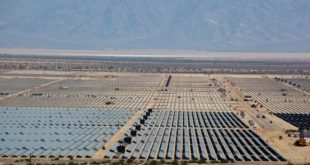The global market for grid-connected residential photovoltaic (PV) solar installations coupled with energy storage is predicted to grow tenfold to reach more than 900 megawatts (MW) in 2018, up from just 90 MW in 2014, according to new analysis from IHS Technology (NYSE: IHS).
This expanding opportunity for PV companies and battery manufacturers largely will be driven by the increasing attractiveness of PV for self-consumption, as well as by subsidies and increasing interest from home owners in becoming more independent of the electricity grid.
These findings can be found in the report entitle, “Energy Storage in PV Report – 2014,” from the Power & Energy service of IHS.
Market barriers to be broken down in 2015
A huge amount of anticipation has surrounded the adoption of energy storage in small PV systems in recent years. However, deployment mostly has failed to live up to the hype. A number of barriers have prevented the market from taking off in line with expectations.
One of the major factors restricting growth has been the performance of the overall PV market.
“The outlook for PV in many major residential solar markets where energy storage is likely to be adopted has weakened considerably during the last year, largely because of reduced government incentives,” said Sam Wilkinson, research manager for energy storage at IHS. “In particular, the IHS forecast from 2014 to 2017 for total residential installations in Italy, Germany and the United Kingdom—three large PV markets—has been reduced by nearly 50 percent since April 2013.”
The high price of both batteries and the power-conversion devices needed to integrate them into PV systems has also remained a major inhibiting factor for the market. Although the average price of lithium-ion (Li-ion) batteries, which account for the majority of residential PV energy storage installations, is estimated to have fallen by 20 percent in 2014, price continues to be a major concern for the industry. The result is that profitable business models for PV energy storage are complex and only exist in a small number of niches, where subsidies and strong interest from end users have enabled the market to grow.
“In situations where a financial justification for adding energy storage to a residential PV system does exist, the business case is highly dependent on several variables, such as the levels of self-consumption that can actually be achieved, and the development of retail electricity rates over the next 20 years,” Wilkinson added. “The fact that these variables are impossible to ensure and so difficult to predict makes the investment relatively insecure and has further hampered end-user appetite for residential PV energy storage.”
The overall picture, however, will improve next year, as huge progress in overcoming many of these barriers is expected in 2015. IHS predicts that average Li-ion prices will fall by a further 15 percent, and the residential PV market will return to growth for the first time in three years. These factors will be critical to spurring a 90 percent expansion in residential PV energy storage in 2015.
Long-term growth aided by self-consumption
While subsidies and growing interest among residential electricity consumers in becoming more independent from the electricity grid will help the residential PV storage market to grow, the principal driver will be the increasing attractiveness of self-consuming the electricity produced by residential PV systems.
In many cases where retail electricity prices are relatively high in comparison to the cost of generating PV, it is more financially attractive to use the electricity produced by a PV system and save money off the electricity bill than it is to sell electricity back to the grid. As the cost of energy storage falls, it is becoming viable to install a battery to store surplus energy, rather than export it to the grid, in order to increase self-consumption.
“The three key variables that determine whether it’s economical to add energy storage to a residential PV system to increase self-consumption are the value of the feed-in tariff, the expense of buying electricity from the grid, and the cost of energy storage products. And all of these metrics are moving in the right direction,” Wilkinson commented. “Although the high cost of batteries means that today in Germany, PV systems without storage offer a greater return on investment than PV systems with storage, IHS predicts that each of these key parameters will have moved to such an extent that this situation will be reversed by 2016.”
PV markets where self-consumption is particularly attractive include Italy, Germany, the U.K. and Australia. These countries combined are predicted to account for more than 40 percent of the residential PV energy storage market in 2018, despite representing only 20 percent of total PV installations.
Other drivers pushing the residential energy storage market forward
Although self-consumption is the most important driver for residential PV energy storage, other factors will play a part in accelerating adoption.
The largest market for residential PV energy storage in 2018 will be Japan, with more than 200 MW of installations, despite generous PV incentives that make self-consumption of PV unattractive. In response to the country’s electricity shortage, a subsidy has been released in Japan to promote the use of Li-ion batteries in residential and commercial buildings. This combined with frequent electricity blackouts and a significant difference between peak and off-peak electricity prices has generated huge interest in PV systems with energy storage attached.
Strong interest in adding energy storage to PV systems in order to provide back-up power also exists. However, IHS predicts that this driver alone will play only a minor role in the growth of the global market.
“Electricity blackouts are relatively uncommon in established PV markets and present little more than an inconvenience in the residential sector,” Wilkinson said. “As a result, only a relatively small market will exist where this is the main driver.”
In North America, which is predicted to be one of the largest residential PV markets in the world in 2018, backup is currently the only driver for PV system owners to add energy storage to their systems. As a result, IHS predicts that residential PV energy storage installations will account for just 5 percent of the global market.
 Alternative Energy HQ solar power for homes, wind energy, and bio fuel issues
Alternative Energy HQ solar power for homes, wind energy, and bio fuel issues


 Goal Zero Switch 10 Multi-Tool
Goal Zero Switch 10 Multi-Tool





